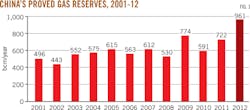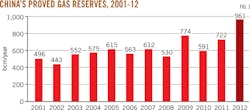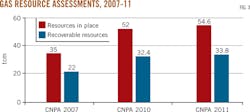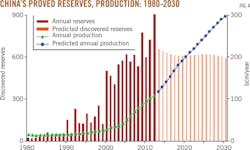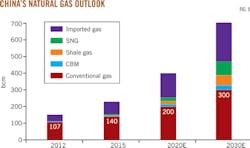China looks ahead to a robust natural gas endowment
Jie Zhu
China University of Geosciences
Chenglin Liu
Chinese Academy of Geological Science
Hulin Yang Daoyong Zhang
Strategic Research Center for Oil & Gas Resources
Ministry of Land of Resources
Beijing
Natural gas plays an important role in China's economic development and energy structure. Proved reserves exceed 600 billion cu m/year (bcm/year), and production has topped 100 bcm/year, ranking China's output the 7th highest in the world.1
After China's National Petroleum Assessment 2007 (CNPA 2007), a reassessment of Bohai Bay, Ordos, and Sichuan basins showed China's gas production could triple by 2030. Sources for this rapid increase of supply also include coalbed methane, shale gas, and synthetic natural gas (SNG).
Demand for oil and gas is fueled by China's industrialization, urbanization, and agricultural modernization. In recent years, the Chinese government has worked to increase natural gas exploration and development to enhance its energy mix and reduce the nation's dependence on coal.
E&P achievements
Through the 1990s, with strong investments in natural gas exploration, China increased its reserves to 200 bcm from 20 bcm.
Since 2000, new exploration has exploited various geologic targets, including thrust structures of foreland basins, marine carbonate reservoirs, stratigraphic lithology traps, and volcanic reservoirs, which has resulted in 18 gas fields with total reserves of more than 100 bcm.
Owing to new discoveries, such as the Tazhong I, Puguang, Jingbian, and Xushen gas fields, China's reserves now stand at 961 bcm (Fig. 1).1
Other regions, such as Sulige, north Tarim, and central Sichuan, have gradually taken shape as natural gas resource deposits with proven reserves of more than 1 trillion cu m (tcm). In the South China Sea, such deepwater discoveries as Liwan 3-1, Liuhua 34-2, and Liuhua 29-1 are adding to China's natural gas endowment (OGJ Online, Sep. 20, 2011).
Increased production
In 2001, China produced 30.3 bcm. By 2012, the country increased its production to 107.1 bcm (Fig. 2).1
The Ordos, Tarim, and Sichuan basins provide most of China's production. In 2012, the Ordos ranked highest with 31.5 bcm/year. Sichuan and Tarim followed with 23.7 bcm/year and 20.2 bcm/year, respectively.
According to CNPA 2007, China's total natural gas resources were 35 tcm with a recoverable volume of 22 tcm. The 2011 CNPA revealed a 56% increase in China's gas resources with total gas in place of 54.6 tcm and a recoverable volume of 33.8 tcm (Fig. 3; OGJ, Feb. 4, 2013, p. 54).
Quantity, quality
As China continues to increase its undiscovered reserves, it is worth noting that researchers have gradually downgraded the quality of much of China's undiscovered natural gas as poor, owing to the apparent increased proportion of low-permeability gas, deepwater gas, deep gas, and gas containing hydrogen sulfide.
Compared with the results of CNPA 2007, CNPA 2011 shows that the proportion of low permeability gas resources has increased to 51% from 38.5%; the proportion of shallow (<2,000 m) and middle deep (2,000-3,500 m) gas has decreased to 42.9% from 52.8%, while the proportion of deep (3,500-4,500 m) and ultradeep (>4,500 m) gas has increased to 57.1% from 47.2% (Table). As a result, exploration is becoming difficult and costs are rising.
For 2012, China's cumulative gas reserves were 5.7 tcm, and cumulative production was 1.3 tcm. China's natural gas resources will continue to grow with continued advancement of exploration technologies and extension of exploration areas.
E&D prospects, production growth
Natural gas proved reserves growth averaged 0.68 tcm/year for 2006-12. With continued momentum through 2030, reserves should exceed 600 bcm/year (Fig. 4).
Favorable gas accumulation conditions in the Sichuan, Ordos, and Tarim basins will lead future discoveries of giant gas fields. In addition, China's foreland basins, cratonic uplifts, large-area stratigraphic lithology zones, and continental shelves will provide areas for further exploration.
In 2012, the aforementioned basins produced 75% of China's natural gas and will continue this trend for the next 20 years. In 2020, these three basins will provide 80% of China's gas production. Qaidam, Songliao, and Bohai Bay basins will account for the remaining 20%.
China will focus on increasing single well output and reservoir management for the next 20 years. The goal is to strengthen development technologies for complex reservoirs rapidly to increase natural gas production in reservoirs with abnormally high pressures, low permeability, and tight gas.
China's production will reach 140 bcm/year in 2015 and up to 300 bcm/year in 2030 (Fig. 3). With price reform a major focus, the country plans to establish price mechanisms that reflect the scarcity of resources.
Unconventional prospects
In recent years, China has investigated the development of coalbed methane (CBM), shale gas, and other unconventional resources.
China's CBM production increased to 2.57 bcm/year in 2012 from 130 million cu m/year in 2006. Currently, CBM production capacity has reached 7 bcm/year. Production capacity could reach 10 bcm with production of 6 bcm/year by 2015. An optimistic estimate suggests 30 bcm/year by 2030.
Meanwhile, shale gas development in China underwent important breakthroughs in 2012. To date, there have been more than 130 shale gas wells drilled. Among these, several displayed productive gas flows, including the Ning-201 and Jiaoye 1 in the southern Sichuan basin. Initial gas production for both wells was about 200,000 cu m/day, which indicates the commercial prospect of China's shale gas.
China should see 5 bcm of shale gas production by 2015, which is slightly less than the target of 6.5 bcm suggested by the government's "Shale Gas Development Planning 2011-2015."2 Technological advances and more investment should increase China's shale gas production to 60 bcm by 2030.
Coal-based SynGas (SNG) is also part of China's move to increase its reserves. At present, the government has approved four large-scale SNG projects with total investment reaching $16.18 billion. Once completed, these projects will produce 15 bcm/year of SNG.
Other coal enterprises and power plants have applied for SNG projects in China. Sinopec currently has SNG projects planned that will produce an estimated 40 bcm/year within the next decade. SNG projects are expected to produce 5 bcm of methane in 2015, but this could reach as high as 600 bcm in 2030 (Fig. 5).
Prediction of supply, demand
The demand for clean energy represented by natural gas has grown with the sustainable development of China's economy. In 2001, China was a net exporter of natural gas with a consumption of 27.4 bcm/year and production of 30.3 bcm. In 2007, China's situation reversed as consumption increased to 70.5 bcm/year with production of only 69.3 bcm/year.
By 2012, China's natural gas consumption and production were, respectively, 147.1 bcm and 107.1 bcm, accounting for an imported natural gas volume of 42.5 bcm. The degree of China's gas export dependence increased to 28.9% in 2012 from 2% in 2006.3
China's economic and social development will remain in a crucial stage of capitalizing on strategic opportunities for the next 20 years. An important measure for China's energy growth includes strengthening the development and domestic use of natural gas.
The country plans to enhance its energy consumption and its ecology by using more natural gas to generate electricity and fuel transport while also increasing residential infrastructure for increased domestic consumption.
By 2015, China anticipates that its natural gas demand will reach 230 bcm and 700 bcm by 2030.
China has increased its natural gas supply capacity by relying on domestic production of conventional, SNG, and unconventional gas resources. Despite improvements, the country continues to meet domestic demand through imports from Central Asian countries, Russia, and the Middle East. By 2030, China's imported natural gas could reach 230 bcm (Fig. 5).
References
1. China's Oil and Gas Reserves Bulletin 2012, China Ministry of Land and Resources, May 1, 2013.
2. Shale Gas Development Planning (2011-15), China Ministry of Land and Resources, Mar. 16, 2012.
3. Domestic and International Oil and Gas Industry Development Report 2012, CNPC Petroleum Economics and Technology Research Institute.
The authors
Jie Zhu ([email protected]) has been with the Strategic Research Center for Oil and Gas Resources of the Ministry of Land and Resources since 2007, working on petroleum resources assessment and energy strategy. He received a BA in petroleum geosciences and a PhD in geological resources and geological engineering from China University of Petroleum.
Chenglin Liu ([email protected]) was with China University of Petroleum working on petroleum resources assessment 2004-12 and has been with the Institute of Geomechanics, Chinese Academy of Geological Science, since 2013. He received a BA in petroleum geosciences and a PhD in mineralogy, petrology, and mineral deposit geology from China University of Petroleum.
Hulin Yang ([email protected]) was with Geological Survey Division, Ministry of Land and Resources, 1986-01. Since 2001, he has served with the Strategic Research Center for Oil and Gas Resources of the Ministry of Land and Resources, working on petroleum resources economic assessment and energy strategy. He holds a BA in economics from NanKai University.
Daoyong Zhang ([email protected]) has been with the Strategic Research Center for Oil and Gas Resources of the Ministry of Land and Resources since 2005, working on petroleum resources assessment. He holds a BA in petroleum geosciences and a PhD from the Research Institute of Petroleum Exploration and Development, PetroChina.
